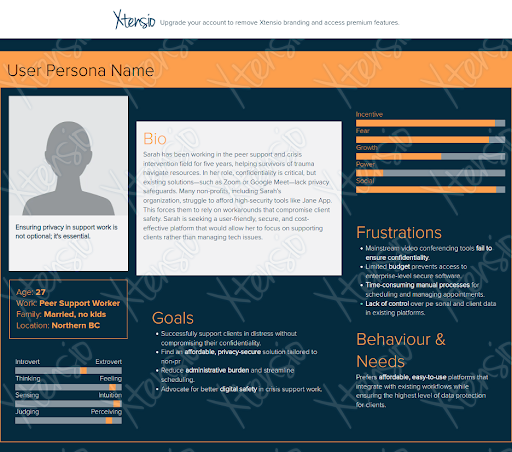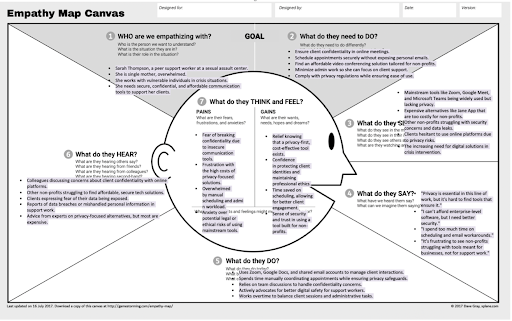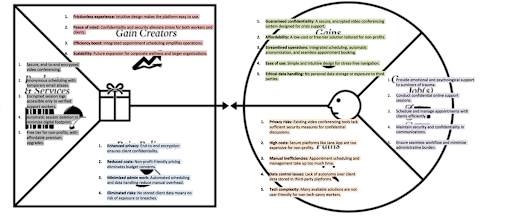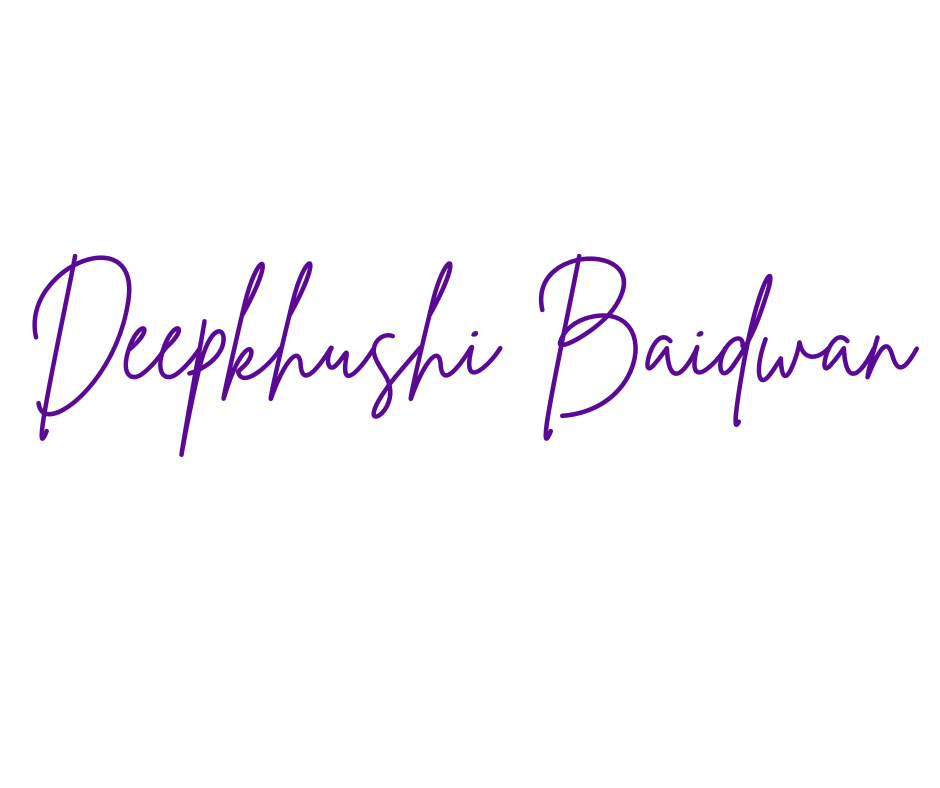UX Case Study + Business Modelling
Safe Haven: Confidential Video Conferencing Tool
Designed a privacy-first web platform for non-profits in the mental health and crisis support sector. Conducted user research with 30 professionals, developed an MVP in Figma, and created business model canvases to validate adoption potential and pricing strategy.

Overview
Safe Haven is a privacy-first video conferencing and scheduling platform designed for non-profits offering trauma-informed mental health and crisis support. With growing data privacy concerns and inaccessible enterprise solutions, Safe Haven was developed to prioritize anonymity, affordability, and ease of use—core needs of peer support professionals and therapy organizations.
- Role: UX Researcher, Product Designer
- Tools: Figma, SurveyMonkey, Xtensio
- Team: Solo Project
- Duration: Jan 2025 – April 2025
- Focus: MVP design, business modeling, user research
Background
Mainstream platforms like Zoom and Google Meet lack sufficient privacy features, while alternatives like Jane App are cost-prohibitive. Peer support professionals—who often work in underfunded, high-stakes environments—are left using insecure workarounds that compromise client safety.
This case study explores the creation and validation of a lean MVP designed to offer secure, anonymous communication without sacrificing usability or accessibility.
Research & Discovery
Methodology
- Survey of 30 professionals from AVP, VSAC, Men’s Therapy Centre
- Mixed methods: Likert, multiple choice, open-ended
Snowball sampling within mental health and support networks
Key Insights
Insight | % of Respondents |
Use video support weekly or more | 70.96% |
Top barrier: Cost of secure platforms | 41.94% |
Most valued feature: Anonymous scheduling | 35.48% |
Willingness to pay $20–49.99/month | 35.48% |
“I spend too much time on manual scheduling and privacy workarounds. It’s exhausting.”
Personas & Empathy Mapping
User Persona

Sarah, 27
Peer Support Worker, Northern BC
![Persona thumbnail here]
- Frustrated by lack of affordable secure tech
- Works with trauma survivors
- Manages scheduling via shared email docs
Empathy Map

Sarah:
- Feels anxious about client data exposure
- Hears others struggling with the same issues
- Does extra admin to maintain confidentiality
Wants a tool built for her real-world constraints
Brainstorming (Business Model + Value Proposition)
Value Proposition Canvas

- Gain creators: Peace of mind, simplified scheduling
- Pain relievers: Encryption, anonymity, low pricing
Jobs to be done: Support clients while protecting their identity
Business Model Canvas

- Customer segments: Crisis centers, therapy orgs, EAPs
- Key activities: MVP dev, nonprofit outreach, compliance
- Revenue model: Freemium + paid tiers ($10–$50/user/month)
Channels: Digital marketing, gov. grants, LinkedIn
Prototyping
A Figma wireframe MVP was created to communicate Safe Haven’s core features visually, enabling validation without development.
Key Screens
- Login page with “Hide My Email”
- Avatar-based dashboard (no personal info shown)
- Scheduling page for anonymous session booking
- Video call interface with incognito mode + alias names
The MVP focused on clear UX cues for security and anonymity while keeping interaction friction low.
Evaluation
Survey results were used to assess content validity, interpretability, and feature clarity.
Finding | Response |
29% did not fully understand MVP | Plan for onboarding tutorial + explainer |
54.84% understood the idea well | Validates MVP direction |
Cost was a top concern | Introduced freemium model |
Privacy was essential for 89% | Confirmed key features: alias, encryption, auto-deletion |
Results & Takeaways
- The MVP successfully communicated Safe Haven’s value, with over half of respondents expressing interest in adopting it.
- Anonymity and encryption were clear feature differentiators.
- A strong need for onboarding and differentiation from Zoom emerged.
Biggest learning: privacy-first UX must be both secure and intuitive — trust is built through clarity.
Future Work
- Clickable prototype with onboarding walkthrough
- Launch explainer website
- Pilot with VSAC or AVP to test retention and usability
Seek grants and partnerships with non-profit networks
Conclusion
Safe Haven is more than just a privacy-focused product—it’s a tool for restoring agency and comfort to professionals handling some of the world’s most vulnerable cases. This project taught me how UX intersects with ethics, policy, and business strategy, and how critical it is to design with compassion.
“Design should protect, not just delight. Safe Haven was a step toward that.”

